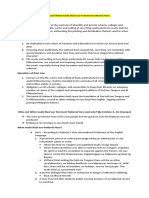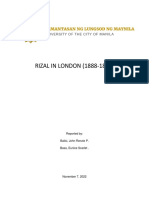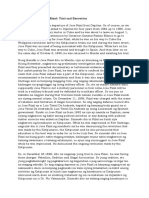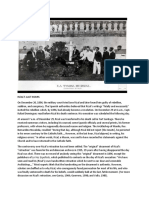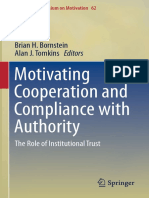0 ratings0% found this document useful (0 votes)
289 viewsUnit 3 - RIzal
Unit 3 - RIzal
Uploaded by
Almine- Rizal enrolled in the University of Santo Tomas in 1877 to study Philosophy and Letters, despite his mother's opposition to further education due to fears of Spanish retaliation.
- While studying at UST, Rizal was also taking vocational courses at Ateneo, including surveying. He excelled in his studies and obtained titles, though he was too young for one title.
- In 1878, Rizal was attacked and slashed by a Spanish military officer in Calamba, but received no justice from authorities when he reported the incident.
- In 1879, Rizal won first prize in a literary contest with his poem "A La Juventud Filipina," making him
Copyright:
© All Rights Reserved
Available Formats
Download as DOCX, PDF, TXT or read online from Scribd
Unit 3 - RIzal
Unit 3 - RIzal
Uploaded by
Almine0 ratings0% found this document useful (0 votes)
289 views3 pages- Rizal enrolled in the University of Santo Tomas in 1877 to study Philosophy and Letters, despite his mother's opposition to further education due to fears of Spanish retaliation.
- While studying at UST, Rizal was also taking vocational courses at Ateneo, including surveying. He excelled in his studies and obtained titles, though he was too young for one title.
- In 1878, Rizal was attacked and slashed by a Spanish military officer in Calamba, but received no justice from authorities when he reported the incident.
- In 1879, Rizal won first prize in a literary contest with his poem "A La Juventud Filipina," making him
Original Description:
Life and Works of Rizal Chapter 3 summarized
Copyright
© © All Rights Reserved
Available Formats
DOCX, PDF, TXT or read online from Scribd
Share this document
Did you find this document useful?
Is this content inappropriate?
- Rizal enrolled in the University of Santo Tomas in 1877 to study Philosophy and Letters, despite his mother's opposition to further education due to fears of Spanish retaliation.
- While studying at UST, Rizal was also taking vocational courses at Ateneo, including surveying. He excelled in his studies and obtained titles, though he was too young for one title.
- In 1878, Rizal was attacked and slashed by a Spanish military officer in Calamba, but received no justice from authorities when he reported the incident.
- In 1879, Rizal won first prize in a literary contest with his poem "A La Juventud Filipina," making him
Copyright:
© All Rights Reserved
Available Formats
Download as DOCX, PDF, TXT or read online from Scribd
Download as docx, pdf, or txt
0 ratings0% found this document useful (0 votes)
289 views3 pagesUnit 3 - RIzal
Unit 3 - RIzal
Uploaded by
Almine- Rizal enrolled in the University of Santo Tomas in 1877 to study Philosophy and Letters, despite his mother's opposition to further education due to fears of Spanish retaliation.
- While studying at UST, Rizal was also taking vocational courses at Ateneo, including surveying. He excelled in his studies and obtained titles, though he was too young for one title.
- In 1878, Rizal was attacked and slashed by a Spanish military officer in Calamba, but received no justice from authorities when he reported the incident.
- In 1879, Rizal won first prize in a literary contest with his poem "A La Juventud Filipina," making him
Copyright:
© All Rights Reserved
Available Formats
Download as DOCX, PDF, TXT or read online from Scribd
Download as docx, pdf, or txt
You are on page 1of 3
MEDICAL STUDIES AT UNIVERSITY OF SANTO During the following term (1878-79), Rizal
THOMAS (UST, 1877-1882) received Ateneo Rector’s advice to study
Mother’s Opposition to Higher Education medicine. He took up medicine course,
After graduating with the highest honors enrolling simultaneously in the preparatory
from the Ateneo, Rizal had to go to the medical course and the regular first year
University of Santo Thomas for higher medical course.
studies. The Bachelor of Arts course during Another reason why he chose medicine for a
the Spanish times was equivalent only to the career was to be able to cure his mother’s
high school and junior college courses today. growing blindness
It merely qualified its graduate to enter a Finishes Surveying Course in Ateneo (1878)
university During his first school term in the University
Both Don Francisco and Paciano wanted Jose of Santo Thomas (1877-78), Rizal also studied
to pursue higher learning in the university. in the Ateneo
But Doña Teodora, who knew what happened He took vocational course leading to the title
to Gom-Bur-Za, vigorously opposed the idea of perito agrimensor (expert suryeyor). In
She told her husband: “Don’t send him to those days , it should be remembered, the
Manila again; he knows enough. If he gets colleges for boys in Manila offered vocational
to know more, the Spaniards will cut off courses in agriculture, commerce,
his head” mechanics, and surveying
Don Francisco kept quiet and told Paciano to Rizal, as usual, excelled in all subjects in the
accompany his younger brother to Manila, surveying course, obtaining gold medals in
despite their mothers’ tears. Jose Rizal agriculture and topography. At the age of 17,
himself was surprised why his mother, who he passed the final examination in the
was a woman of education and culture, surveying course, but he could not be
should object to his desire for a university granted the title as surveyor because he was
education below age
Years later, Jose wrote in his journal; ”Did The title was issued to him on November
my mother perhaps have a foreboding of 25,1881
what would happen to me? Does a Although Rizal was Thomasian, he frequently
mother’s heart really have a second visited Ateneo, not only to his course but also
sight?” more because if his loyalty to Ateneo, where
Rizal Enters the University he made beautiful memories and whose
in April 1877, Rizal who was then nearly 16 Jesuit professors, unlike the Dominicans, who
years old, matriculated in the University of loved him and inspired him to ascend to
Santo Thomas, taking the course on greater heights of knowledge
Philosophy and Letters He was the president of the Academy of
He enrolled in this course for two reasons: Spanish Literature and secretary of the
1. His father liked it Academy of Natural Sciences. He also
2. He was “still uncertain as to what career to continued his membership in the Marian
pursue” Congregation, of which he was the secretary
He had written to Father Pablo Ramon, Romances with Other Girls
Rector of the Ateneo, who had been good to 1. Miss L – he courted in Calamba, described her
him during his student days in that college, as ‘fair with seductive and attractive eyes’.
asking for advice on the choice of a career. After several visiting in her house, he
But Father Rector was then in Mindanao so stopped wooing due to romance died in
that he was unable to advise Rizal natural death
During Rizal’s first-year-term (1877-78) in the a. The sweet memory of Segunda was
UST, he studied; Cosmology, Metaphysics, still fresh in his memories
Theodicy, and History of Philosophy b. His father did not like her family
2. Leonor Valenzuela (Orang) – sophomore year, literary contest. It offered a prize for the
daughter of his neighbor in boarding house of best poem by a native or a mestizo
Doña Concha Leyva in Intramuros. He courted Rizal, who was then 18 years old, submitted
‘tall girl with a regal bearing’, sent her love his poem entitled A La Juventud Filipina
notes written in invisible ink A La Juventud Filipina is an inspiring poem of
a. Like Segunda, he stopped short of flawless form. In exquisite verses, Rizal
proposing marriage to Orang beseeched the Filipino youth to rise from
3. Leonor Rivera (Taimis) – his cousin from lethargy, to let their geniuses fly swifter than
Calimiling. A student at La Concordia the wind and descend with art and science to
College, where Soledad was then studying. A break the chains that have long bound the
frail, pretty girl ‘tender as a budding flower spirit of the people
with kindly, wistful eyes’ The Board of Judges, composed of Spaniards,
a. They became engaged, in letters to was impressed by Rizal’s poem and give it
Rizal, Leonor signed her name as the first prize which consisted of a silver
“Taimis” in order to camouflaged their pen, feathered-shaped and decorated with a
intimate relationship from their gold ribbon
parents and friends The winning poem of Rizal is a classic in
Victim of Spanish Officer’s Brutality Philippine Literature for two reasons;
When Rizal was a freshman medical student 1. It was the first great poem in Spanish written
at the UST, he experienced his first taste of by a Filipino, whose merit was recognized by
Spanish brutality Spanish literary authorities
One dark night in Calamba, during the 2. It expressed for the first time the
summer vacation in 1878, he was walking in nationalistic concept that the Filipinos, and
the street, he dimly perceived the figure of a not the foreigners, were the ‘fair hope of
man while passing him. the Fatherland’
Not knowing the person due to darkness, he EL CONSEJO DE LOS DIOSES - THE COUNCIL OF
did not salute nor say a courteous “Good THE GODS (1880)
Evening”. The vague figure turned out to be The following year (1880) the Artistic-
a lieutenant of the Guardia Civil. Literary Lyceum opened another Literary
With a snarl, he turned upon Rizal, whipped contest to commemorate the fourth
out his sword and brutally slashed the latter centennial of the death of Cervantes, Spain’s
on the back. The wound was not serious, but glorified man-of-letters and famous author of
it was painful Don-Quixote. This time the contest was
When Rizal recovered, he reported the opened to both Filipinos and Spaniards
incident to General Primo de Rivera, the Many writer participated in the contest –
Spanish governor general of the Philippines at priest, newspapermen, scholars and
that time. But nothing came out of his professors. Rizal, inspired by his poetical
complaint, because he was an Indio and the triumph the previous year, entered the
abusive lieutenant was a Spaniard literary joust, submitting an allegorical
Later, in a letter to Bluemintritt, dated drama entitles El Consejo de los Dioses
March 21, 1887, he related; ”I went to the After a long and critical appraisal of the
Captain-General but I could not obtain entries, they awarded the first prize to
justice; my wound lasted two weeks” Rizal’s work because of its literary
A LA JUVENTUD FILIPINA (TO THE FILIPINO superiority over the others
YOUTH) The Spanish community in Manila, spear-
In the year 1879 the Liceo Artistico-Literario headed by the Spanish press, howled in great
(Artistic-Literary Lyceum) of Manila, a indignation against the decision because the
society of literary men and artists, held a winning author was an Indio
Despite all objections, the prize was awarded Rizal was the chief of this secret student
to Rizal, a gold ring on which was engraved society, with his cousin from Batangas,
the bust of Cervantes. For the first time in Galicano Apacible, as a secretary.
history, an Indio – a 19 year old Filipino As chief, he led the Filipino students into
medical student at that – excelled in a combat against the Spanish students in
national literary contest, defeating several various street fights. In one of the fierce
Spanish writers of his time in Manila encounters between the Filipino students and
Rizal was particularly happy, for he proved their pale-skinned detractors near the
the fallacy of the alleged Spanish superiority Escolta in Manila, Rizal was wounded on the
over the Filipinos and revealed that the head
Filipino could hold his own in fair His friends brought him bleeding and covered
competition against all races with dust to his boarding house, “Casa
The winning allegory of Rizal was a literary Tomasina”. Leonor Rivera tenderly washed
masterpiece based on the Greek classics. The and dressed his wound (AYIEE, DI DIN NAMAN
allegory established a parallel among Homer, NAGKATULUYAN SA HULI)
Virgil, and Cervantes
The gods discuss the comparative merits of
these great writers and finally decide to give
the trumpet to Homer, the lyre to Virgil, and
the laurel to Cervantes
The allegory gloriously closes with the
naiads, nymphs, satyrs, and other
mythological characters dancing and
gathering laurels for Cervantes
CHAMPION OF FILIPINO STUDENTS
Rizal was the champion of Filipino students in
their frequent fights against the arrogant
Spanish students, who were often surpassed
by the Filipinos in class work and who
insultingly called their brown classmates –
“Indio, chongo!” (YOU FILTHY MUDBLOOD!)
In retaliation, the Filipino students called
them “Kastila, bangus!” Hostility between
these two groups of students often exploded
in angry street rumbles (GRYFFINDOR’S VS
SLYTHERIN’S)
Rizal participated in these student brawls.
Owning to his skill in fencing, his prowess in
wrestling, and his indomitable courage, he
distinguished himself in these student
skirmishes
In 1880 he founded a secret society of
Filipino students in the UST, called
Compañerismo (Comradeship) whose
members were called “Companions of
Jehu” (DUMBLEDORE’S ARMY) after the
valiant Hebrew general who fought the
Armaens and ruled the Kingdom of Israel for
28 years (843-816 B.C)
You might also like
- William Cheng 2014 - Sound Play - Video Games and The Musical ImaginationDocument250 pagesWilliam Cheng 2014 - Sound Play - Video Games and The Musical ImaginationRam YahyaNo ratings yet
- Reviewer - Life and Works of RizalDocument7 pagesReviewer - Life and Works of RizalAlmine75% (4)
- Life and Work of Rizal Notes FinalDocument12 pagesLife and Work of Rizal Notes FinalRio Awitin100% (1)
- Rizal Module 10 JCDocument12 pagesRizal Module 10 JCFer-J TagacayNo ratings yet
- Linear Integrated CircuitsDocument22 pagesLinear Integrated CircuitsKavi ThaNo ratings yet
- Different Seasons GuideDocument4 pagesDifferent Seasons Guidejmosutton9170% (1)
- Chapter 5 Rizal - USTDocument26 pagesChapter 5 Rizal - USTAchie AlvarezNo ratings yet
- Rizals Life Higher Education and Life AbroadDocument38 pagesRizals Life Higher Education and Life Abroadkenneth sethNo ratings yet
- Chapter 6 Jose Rizal's Life, Works and WritingsDocument2 pagesChapter 6 Jose Rizal's Life, Works and Writingselechar morenoNo ratings yet
- Chapter 14-Life and Writings of RizalDocument2 pagesChapter 14-Life and Writings of RizalSteave Marville Pascual50% (2)
- Rizal Report Rea and GacetaDocument20 pagesRizal Report Rea and Gacetacherry simonNo ratings yet
- Unit 1 - RizalDocument3 pagesUnit 1 - RizalAlmineNo ratings yet
- Chapter 24Document8 pagesChapter 24MhiahLine TolentinoNo ratings yet
- Life of RizalDocument6 pagesLife of Rizal'Ardee TafallaNo ratings yet
- Chapter 22 Exile in DapitanDocument9 pagesChapter 22 Exile in DapitanNiño Dwayne TuboNo ratings yet
- Life and Works of Rizal Midterm ReviewerDocument7 pagesLife and Works of Rizal Midterm ReviewerMargaret Joy SobredillaNo ratings yet
- Rizal in SpainDocument3 pagesRizal in SpainPein Valentine MooncreusNo ratings yet
- Rizal PDFDocument14 pagesRizal PDFMarialyn RedobleNo ratings yet
- Rizal Summaries Chapter 1 13Document3 pagesRizal Summaries Chapter 1 13Renjan Solis50% (2)
- Quiz 3 RizalDocument1 pageQuiz 3 RizalViances CristobalNo ratings yet
- UNIT III Rizal Part 1Document35 pagesUNIT III Rizal Part 1danilo pastorfideNo ratings yet
- The Second Homecoming of RizalDocument5 pagesThe Second Homecoming of RizalMa. Louigie AgangNo ratings yet
- Life and Works of Jose Rizal.......Document6 pagesLife and Works of Jose Rizal.......Xyrelle ManceraNo ratings yet
- Chapter 4 Scholastic Triumphs at Ateneo de Manila AutosavedDocument23 pagesChapter 4 Scholastic Triumphs at Ateneo de Manila AutosavedOlib OlieNo ratings yet
- Chapter 24 Last Home Coming and TrialDocument17 pagesChapter 24 Last Home Coming and Trialwinnots95% (22)
- Group 10 Rizal in LondonDocument10 pagesGroup 10 Rizal in LondonJared PaulateNo ratings yet
- The Second Homecoming and The Liga FilipinaDocument23 pagesThe Second Homecoming and The Liga FilipinaLizzette ApondarNo ratings yet
- The Last Days of Jose Rizal: Trial and ExecutionDocument4 pagesThe Last Days of Jose Rizal: Trial and ExecutionKyle VillarizaNo ratings yet
- This Was Done Allegedly in The Following MannerDocument5 pagesThis Was Done Allegedly in The Following MannercypherNo ratings yet
- 3-Rizal's Education and Life AbroadDocument26 pages3-Rizal's Education and Life AbroadSamantha AngitNo ratings yet
- Early Education in Calamba and BinanDocument9 pagesEarly Education in Calamba and Binanmangeggenver43No ratings yet
- Rizal As A Translator: 1. Gmaria Jessa Joy A. LopezDocument34 pagesRizal As A Translator: 1. Gmaria Jessa Joy A. LopezJessa Joy Alano LopezNo ratings yet
- Rizal Chapter 5Document18 pagesRizal Chapter 5Meow MeowNo ratings yet
- Learning Module For College Rizal'S Life and Works: Corrupt Spanish OfficialsDocument4 pagesLearning Module For College Rizal'S Life and Works: Corrupt Spanish OfficialsVANESA MANZONNo ratings yet
- Week 9 Rizals Life and Works in London and ParisDocument33 pagesWeek 9 Rizals Life and Works in London and ParisVencint LaranNo ratings yet
- Biography of José Rizal, National Hero of The PhilippinesDocument4 pagesBiography of José Rizal, National Hero of The PhilippinesCHRISTENE FEB LACHICANo ratings yet
- Rizal's Travel - Singapore Group 3 TTH - 7:30 - 9:00 A.MDocument2 pagesRizal's Travel - Singapore Group 3 TTH - 7:30 - 9:00 A.MAngelique DubouzetNo ratings yet
- The Life and Legacy of José Rizal - National Hero of The Philippines PDFDocument3 pagesThe Life and Legacy of José Rizal - National Hero of The Philippines PDFEverything Is KpopNo ratings yet
- The Visionary Journalist in Paris and BrusselsDocument36 pagesThe Visionary Journalist in Paris and BrusselsdionnNo ratings yet
- Lesson 14 - Rizals Last HomecomingDocument22 pagesLesson 14 - Rizals Last HomecomingImrenz Real WorkNo ratings yet
- Rizal 5Document24 pagesRizal 5Janille Audrey DulayNo ratings yet
- Paris To Berlin RizalDocument21 pagesParis To Berlin RizalLeo Jade AbiertasNo ratings yet
- RIzal Chilhood and Early EducationDocument40 pagesRIzal Chilhood and Early EducationJohn Paulo SuladayNo ratings yet
- Rizal's Life: April Joyce Galang ReporterDocument39 pagesRizal's Life: April Joyce Galang ReporterapriljoycegalangNo ratings yet
- Famous Novels of Rizal Part2Document95 pagesFamous Novels of Rizal Part2Jackelyn J. PerandosNo ratings yet
- Lester D. Amado Bs Electrical Engineering-2 Rizal'S Life: Exile, Trial and Death ReflectionDocument3 pagesLester D. Amado Bs Electrical Engineering-2 Rizal'S Life: Exile, Trial and Death ReflectionLester AmadoNo ratings yet
- Rizal's Last HoursDocument2 pagesRizal's Last HoursDisza Jane FamadorNo ratings yet
- Rizal 6-10Document35 pagesRizal 6-10Sittie Hijara100% (1)
- Jose Rizal's Trip To Hong Kong and MacauDocument27 pagesJose Rizal's Trip To Hong Kong and MacauRtvc RoldanNo ratings yet
- Trial and Martyrdom of Jose RizalDocument13 pagesTrial and Martyrdom of Jose RizalGanie Mar BiasonNo ratings yet
- Chapter 16 RizalDocument11 pagesChapter 16 RizalJade GilNo ratings yet
- Chapter 4: Rizal's Life: Higher Education and Life AbroadDocument19 pagesChapter 4: Rizal's Life: Higher Education and Life Abroadagcaoili niloNo ratings yet
- Chapter 4Document28 pagesChapter 4Jerome GianganNo ratings yet
- Life and Works of Jose Rizal: Prelim MidtermDocument23 pagesLife and Works of Jose Rizal: Prelim MidtermKang ChulNo ratings yet
- Rizal The Romantic SermonaDocument10 pagesRizal The Romantic SermonaEduardo SandoyNo ratings yet
- Jose Rizal: A Biographical SketchDocument17 pagesJose Rizal: A Biographical SketchGideon C. TaquinesNo ratings yet
- MEDICAL STUDIES AT THE UNIVERSITY OF SANTO TOMAS and Travels Part 1Document36 pagesMEDICAL STUDIES AT THE UNIVERSITY OF SANTO TOMAS and Travels Part 1Rose Belle A. Garcia100% (1)
- Rizal 1888-1892Document9 pagesRizal 1888-1892EmmanuelRodriguez100% (2)
- Early Education in Calamba and BiñanDocument4 pagesEarly Education in Calamba and Biñanjunie100% (1)
- LEONOR RIVERA All About HerDocument2 pagesLEONOR RIVERA All About HerRAMNo ratings yet
- Chapter 6Document3 pagesChapter 6jeselyn3delalamon3riNo ratings yet
- Friars and Filipinos An Abridged Translation of Dr. Jose Rizal's Tagalog Novel, 'Noli Me Tangere.'From EverandFriars and Filipinos An Abridged Translation of Dr. Jose Rizal's Tagalog Novel, 'Noli Me Tangere.'No ratings yet
- CONTRACTS (Arts. 1305-1317.) General ProvisionsDocument20 pagesCONTRACTS (Arts. 1305-1317.) General ProvisionsAlmineNo ratings yet
- Contracts: ContractDocument11 pagesContracts: ContractAlmineNo ratings yet
- Notes ObliConDocument3 pagesNotes ObliConAlmineNo ratings yet
- ARTICLE 1179: Section 1. Pure and Conditional ObligationsDocument2 pagesARTICLE 1179: Section 1. Pure and Conditional ObligationsAlmineNo ratings yet
- Unit IV - Education and Travel Abroad: 1. Universidad Central de Madrid 2. Rizal As MasonDocument2 pagesUnit IV - Education and Travel Abroad: 1. Universidad Central de Madrid 2. Rizal As MasonAlmineNo ratings yet
- Cause and ObjectDocument30 pagesCause and ObjectAlmineNo ratings yet
- 21 Inclusion and Exclusion of GiDocument15 pages21 Inclusion and Exclusion of GiAlmineNo ratings yet
- Law - Reccissible and Voidable ContractsDocument8 pagesLaw - Reccissible and Voidable ContractsAlmineNo ratings yet
- Unit 4 - Rizal (3&4)Document4 pagesUnit 4 - Rizal (3&4)AlmineNo ratings yet
- Life and Works of Rizal SummaryDocument73 pagesLife and Works of Rizal SummaryAlmine100% (2)
- Unit 4 - Eudcation and Travels AbroadDocument4 pagesUnit 4 - Eudcation and Travels AbroadAlmineNo ratings yet
- Boyhood Influences: Unit - 2 Rizal'S Chldhood TopicsDocument3 pagesBoyhood Influences: Unit - 2 Rizal'S Chldhood TopicsAlmineNo ratings yet
- Unit 1 - RizalDocument3 pagesUnit 1 - RizalAlmineNo ratings yet
- Unit-5 Homecoming and Return To EuropeDocument11 pagesUnit-5 Homecoming and Return To EuropeAlmine50% (4)
- Life Ni RizalDocument26 pagesLife Ni RizalAlmineNo ratings yet
- Motivating Cooperation and Compliance With Authority: Brian H. Bornstein Alan J. Tomkins EditorsDocument231 pagesMotivating Cooperation and Compliance With Authority: Brian H. Bornstein Alan J. Tomkins EditorsValentinaBekina100% (1)
- Bungo Stray Dogs - Volume 07 (Yen Press) (Kobo - LNWNCentral)Document138 pagesBungo Stray Dogs - Volume 07 (Yen Press) (Kobo - LNWNCentral)rosmala dewiNo ratings yet
- Unit 8: Honey, You're Sleep-Walking AgainDocument8 pagesUnit 8: Honey, You're Sleep-Walking Againhanafi officialNo ratings yet
- SHS Module 1-3Document10 pagesSHS Module 1-3Kath PalabricaNo ratings yet
- Research Paper Dedication Page SampleDocument5 pagesResearch Paper Dedication Page Sampletcwqbmrif100% (1)
- SAT Suite Question Bank - ResultsDocument61 pagesSAT Suite Question Bank - ResultspranshusinghmainNo ratings yet
- Adventists and Fiction: Another LookDocument4 pagesAdventists and Fiction: Another Lookjmordhorst2No ratings yet
- Forms and Types of Creative NonfictionDocument2 pagesForms and Types of Creative NonfictionEmelyn HuboNo ratings yet
- PreviewDocument58 pagesPreviewRomelink Mark0% (1)
- Exercise 1Document13 pagesExercise 1Tham NguyenNo ratings yet
- The Kalahari Typing School For Men4Document90 pagesThe Kalahari Typing School For Men4Alper GümüştekinNo ratings yet
- Juncus Maritimus: Historic PensDocument1 pageJuncus Maritimus: Historic PensRyanNo ratings yet
- Continuous Writing For SPM 4 CekalDocument5 pagesContinuous Writing For SPM 4 CekalNoor AimanNo ratings yet
- Kupdf Net PDF Logo Modernism English FreDocument5 pagesKupdf Net PDF Logo Modernism English Fremanojprabakar1010.mpNo ratings yet
- The Secret Life of Walter Mitty EssayDocument5 pagesThe Secret Life of Walter Mitty Essaydshyylbaf100% (2)
- The Worship of The Wealthy by GDocument2 pagesThe Worship of The Wealthy by GBalaji Mp100% (1)
- Funny Thesis StatementsDocument4 pagesFunny Thesis Statementsdwham6h1100% (2)
- James Wright "A Blessing"Document1 pageJames Wright "A Blessing"Kevo KarisNo ratings yet
- SCBD 1Document30 pagesSCBD 1AdityaNo ratings yet
- Edgar Allan Poe Research PaperDocument6 pagesEdgar Allan Poe Research PaperDavid_Shew_9065No ratings yet
- Creative Writing: Module 3 Contents/ LessonsDocument4 pagesCreative Writing: Module 3 Contents/ LessonsAnne Legaspi GamboaNo ratings yet
- Russian Silver Age Poetry: Texts and ContextsDocument618 pagesRussian Silver Age Poetry: Texts and ContextsAlexandru DonțuNo ratings yet
- Read A Story Explore The Math PDFDocument65 pagesRead A Story Explore The Math PDFManisah Mohd ShahNo ratings yet
- Diary of A Wimpy Kid Double Down 1Document110 pagesDiary of A Wimpy Kid Double Down 1Eslam Khaled49% (35)
- LH-1-01 Revision No. 0 Effectivity: April 15, 2019Document61 pagesLH-1-01 Revision No. 0 Effectivity: April 15, 2019JANNICYL MARIANONo ratings yet
- If Wants To Be The Same As IsDocument313 pagesIf Wants To Be The Same As IsEkaterina ZakharkivNo ratings yet
- 引用注释Document11 pages引用注释ewbkxyjwNo ratings yet


